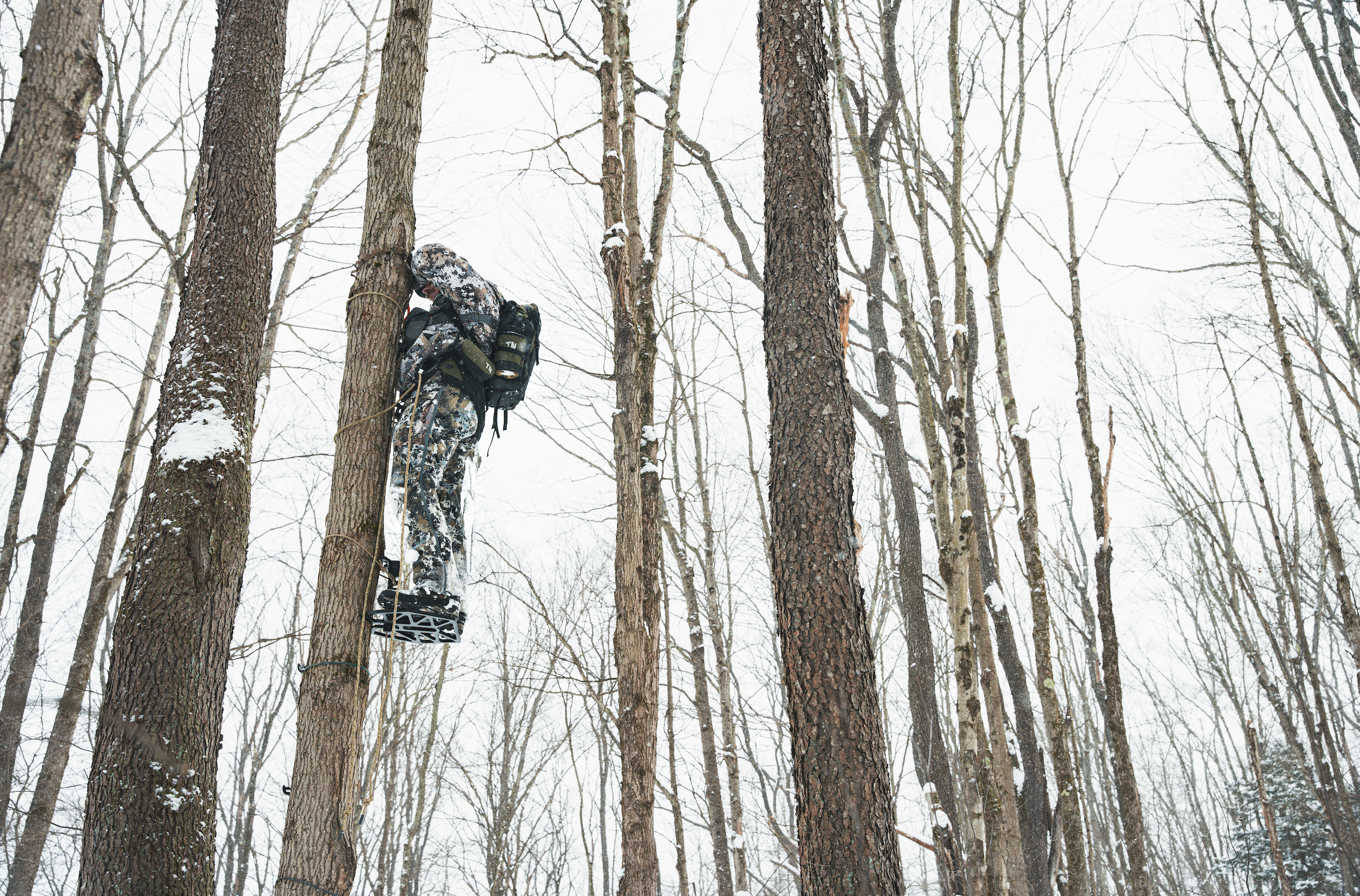Article By: Beau Martonik, East Meets West Hunt Podcast
Hunting from a saddle is one method to stay mobile, travel light, and hunt efficiently. I started hunting from a saddle in 2019 and haven’t looked back.
A saddle is a fall restraint device with lineman’s belt loops, leg straps, belt, and bridge that keeps you secure while climbing trees and hunting. To hunt from a saddle, you need a saddle, saddle bags, lineman’s rope, tree tether, platform, and climbing aid. You can add other accessories to make you more comfortable, but these are the essentials.
The tree tether and lineman’s rope will likely come with a prusik attachment method manually adjusted with your hand. You can add a mechanical ascender, like a Kong Duck, to make the one-handed adjustment easier in colder weather and tighten the rope while under load. This is not a necessary piece of equipment but a “nice to have.”

Types of Saddles:
There are two main types of saddles: two-panel saddles and single-panel saddles. Each type offers distinct advantages and features tailored to different hunting preferences. Two-panel saddles are designed for all-day comfort and provide adjustability for a better fit, especially when dealing with hip pinch, like the Timber Ninja Ultimate. These saddles are built with padding to enhance comfort during long hunting sessions. Single-panel saddles, like the Nano, prioritize lightweight design and versatility.
To simplify it, if you prioritize extremely lightweight and minimalism - maybe a single panel is right for you. If you prioritize comfort and regularly do all-day sits - maybe a two-panel saddle is a better choice.


How to Properly Wear a Saddle
Wearing a saddle is a straightforward process. Start by stepping through your bridge and pulling the saddle above your waist. Connect your waist belt, adjusting the height of the top of your saddle on your hips according to the type of saddle. Most single panels sit on the hips, while the Timber Ninja Nano saddle, made from 4-way stretch material, should be positioned just above your hips to wrap around your body.
Next, you want to secure the leg straps to the appropriate spots. They don’t need to be too tight, but I do think they play a role in keeping you secure if you do fall. If you have an adjustable bridge, you can keep that tightened up and out of the way while climbing and then extend it depending on your tree and which way it is leaning. However, I really try to avoid trees that are leaning toward me. That just might mean you have to shift your platform position slightly. When wearing your saddle correctly, it is nearly impossible to fall. The difference between a fall restraint device (a saddle) or fall protection equipment (full-body treestand harness) is that the fall restraint device is to prevent you from falling in the first place.

Practicing With Your Saddle at Ground Level
Before climbing into the tree, you should practice with your saddle at ground level. Set the platform above the ground by tightening the attachment method around the tree. Once it’s secure, lift up on the platform, place your boot on the top or push down with your hand to set it, and then cam the platform over, ensuring it’s secure.
The height of the tether will be mostly preference, but a good rule of thumb is in between your forehead and chest level. Personally, I like mine lower, so I take advantage of the weak side shot more accessible. Trying different tether heights and practicing with different trees will help you find your sweet spot.
There are four different shots saddle hunters can take. We’ll address them from the perspective of right-handed shooters moving counterclockwise around the tree.
The Four Types of Shots From a Saddle:
- The Strong Side Shot (10 o’clock to 7 o’clock)
- The Back Shot (7 o’clock to 5 o’clock)
- The Weak Side Shot (5 o’clock to 2 o’clock)
- The Front Shot (2 o’clock to 10 o’clock)
There are a few ways to access the weak side shot. You can either spin around counter-clockwise, spin around counter-clockwise while standing on your platform with your rope over your shoulder (you need your tether higher for this) or pull your bow or gun over your bridge. It helps to have a bigger platform for the second and third methods. The third option is my preferred method, as I feel it limits movement.
Proper shooting form is easier to maintain in a saddle versus a traditional tree stand. The geometry created by the saddle makes the “T” form more natural and less likely that you will drop your shoulder. When possible, use your knee to contact the tree for additional stability.

Climbing the Tree
Once I ascend the tree, I place our first step about knee high. You want a safe first step off the ground. If you use a climbing aider in addition to the climbing stick, you will put the first step of the aider at knee height. Placing the bottom step much higher than that isn’t a big deal for going up, but coming down in the dark can be a problem when you think you’re closer to the ground than you really are. Believe me, I know this from experience.
Before you start climbing, swing your lineman’s rope around the tree. This important piece of safety equipment allows you to use your hands to set sticks and the stand while keeping you safely attached to the tree. Once your first stick is up, grab your second stick and attach it to the tree. Once strapped to the tree, you want to set the stick into it by adding some weight to it so it really grips in. When climbing, grab the tree with your hand rather than the step. There’s no chance of the tree going anywhere. Repeat until you are at your desired height. In addition, I like to make sure I have a good, sharp knife on me in a place I can easily get to it. If you were to fall a few feet off the ground but couldn’t get back to your sticks for whatever reason, it can be used to cut your rope and save you from suspension trauma. It’s a long shot that you would ever need that, but if you are carrying a knife anyway, it doesn’t hurt to have it within arm’s reach.
I like to set the first and second sticks while at ground level and then attach an additional climbing stick on each side of my saddle while I’m climbing so I never need to go back down to the ground. The Timber Ninja magnetic stick clips that come with the Ultimate and Nano saddles make this easy. I clip the saddle platform on the back of the saddle while climbing using the same method. Lastly, I will wear my backpack with my bow or gun attached to the back so that no gear is pulled up. If you aren’t comfortable with doing that, you can always attach a gear line to those items to pull up once you are set in place.
Once you get to your top stick, you’ll need to visualize where your platform will go. You don’t want to have to pull yourself up into the platform, but rather step over or down onto your platform. After a platform is set, it’s great if you can kinda test the stand slowly before you put all your weight on it.

Setting Your Saddle Platform
Once your sticks are set, fix the platform to the tree using the provided system, making sure it's level and secure. Cam buckles are the easiest attachment methods for beginners, but if you are looking for an extremely quiet and lightweight attachment method, check out the Timber Ninja SSP rope system.
Before stepping onto the platform, you must cinch it into the tree. This is called camming the platform. Fold the platform up, which will loosen the straps. Cinch those down even tighter and then push the platform back down, making it bite into that tree. Ensure it’s tight, but not so tight that the straps pop when weight is added. With the SSP, you don’t want it to be too tight, or you won’t be able to cam the platform over.

Getting Setup in the Tree
With your lineman’s rope on and connected to the tree, attach your tree tether above your platform at about forehead height. Clip your tether carabiner onto your saddle bridge. Now, you can slowly step into the platform with two methods of being tied off. This is the time to adjust your saddle bridge to the right length (if it’s adjustable). I tend to want my bridge to be a little longer and cinch the tether tight to the tree so there’s more of an angle on the bridge, reducing the odds of hip pinch.
Once you are secure, you can remove the lineman’s rope since you are securely connected with the tree tether to your bridge. The last step is to hang your essentials like your bow or gun, your pack, and anything else you want to have readily available. For right-handed shooters, having your bow on the left side of the tree and your pack down lower on the right will optimize shot opportunities and allow you to have everything readily available.
When you come back down, you do everything in reverse order, ensuring you are always 100% tied off.
That’s everything you need to hunt from a saddle safely. The important thing is to practice repeatedly in your backyard before going out into the woods. Learning to do the simple things perfectly, will make you more efficient, safer, and deadly in hunting season.

Beau Martonik’s Saddle Hunting Gear List:
- Saddle - Timber Ninja Nano or Ultimate Saddle
- Saddle Bags - Timber Ninja Premium Saddle Bags
- Tree Tether - 8mm tether with Kong Duck Ascender
- Linemans Rope - 8mm Linemans Rope with Kong Duck Ascender and Kong Duck Carabiner
- Climbing Sticks - (4) Timber Ninja C1 Climbing Sticks - bottom stick has a retractable aider
- Saddle Platform - Timber Ninja Ledge
- Gear Strap - Jakt Gear UTG Tree Toolbelt
- Gear Hooks - Gear Aid Heroclip for bow hanger, Kong Duck Carabiner for Backpack
- Knife - Case Marilla




